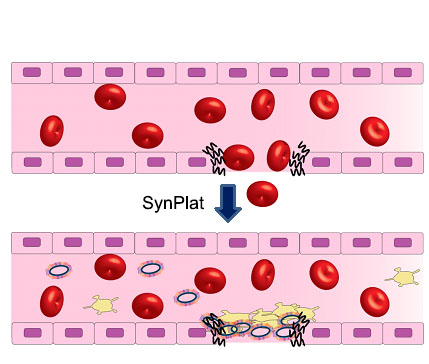Synthetic Platelets (SynPlats) to Treat Internal & External Bleeding
Tech ID: 24143 / UC Case 2014-452-0
Brief Description
Biomaterial nano-particles that mimic the key structural and functional attributes of platelets and have been shown to greatly reduce bleeding time both internally and externally.
Background
Exsanguination, the complete loss of blood, causing death, is responsible for 3 million deaths worldwide due to trauma, and is the leading cause of death in the military. Hemostatic agents are currently used to control excessive bleeding, however this method is not always effective. Today’s hemostatic agents are externally administered in the form of a hemostatic-containing gauze pad, which limits treatment of excessive bleeding to solely externally accessible wounds. The only treatment available to stop internal bleeding is surgery, and the control of bleeding is essential and critical in surgical procedures to minimize blood loss, reduce post-surgical complications, and to shorten the duration of the surgery in the operating room. Exsanguination is one of the leading preventable causes of death, indicating that new advancements in technology are needed to treat hypovolemia — a state of decreased blood volume — and reduce the death count by exsanguination.
Description
Researchers at the University of California, Santa Barbara have developed a nanoscale synthetic hemostatic agent inspired by the design of natural platelets. SynPlats were synthesized via layer-by-layer assembly of globular proteins on a polymer template to yield capsules mechanically and morphologically similar to circulatory cells. These SynPlats can be specialized for a variety of roles by linking function-promoting peptides. In particular, hemostasis-promoting peptides were used to direct SynPlats to affected areas where they can begin the clotting process. Through extensive testing, these synthetic platelets have proven to reduce bleeding time internally and externally by as much as 65%. SynPlats offer a novel nanomaterial that mimics the function of natural platelets and offers a new tool in emergency medicine.

Figure: Hemostatic mechanism of synthetic nanoplatelets. Schematic showing endothelial damage: red blood cells flowing out of the wound at time = 0s and primary platelets interacting with synthetic nanoplatelets forming the hemostatic plug at following injury.
LINK TO PUBLICATION: http://pubs.acs.org/doi/abs/10.1021/nn503732m
Advantages
• Non-surgical treatment of internal bleeding
• Can be used in combination with current hypovolemia treatments
• Increased efficiency in treating hypovolemia
Applications
• Treatment of hypovolemia and prevention of exsanguination
• Tool to control blood loss in emergency medicine
Patent Status
Patent Pending
Contact
- University of California, Santa Barbara Office of Technology & Industry Alliances
- padilla@tia.ucsb.edu
- tel: View Phone Number.
Inventors
- Anselmo, Aaron
- Menegatti, Stefano
- Mitragotri, Samir S.
Other Information
Keywords
SynPlats, platelets, blood clotting, hypovolemia, synthetic, artificial, indpharma, indadvmat
Additional Technologies by these Inventors
- Polymer-Drug Conjugates for the Co-delivery of Synergistic Chemotherapy Drugs
- Multiple Nanoemulsions and Complex Nanoparticles for Encapsulation and Release
- Soft Tissue Augmentation by Needle-Free Injection
- Systems, Methods and Devices for Rapid Tissue-Based Diagnosis
- Mucoadhesive Devices for Oral Delivery of Various Active Agents
